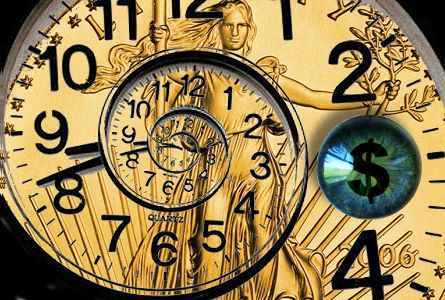By Mark Ferguson
I recently completed a coin appraisal in which each coin was worth around $50,000. In the process of performing the appraisal questions came up about liquidation value as compared to replacement value.
First of all, there is not just one price that a rare coin trades for, as price guides suggest. They trade in a price range. One of the fundamental reasons there’s a price range for rare coins is their variation in quality within a grade. For example, in the MS 65 grade, there will be “A” quality coins, in which those coins are the best for the grade, nearly making the next grade. Then there are “B” quality coins that are still above average. “C” quality coins would be average quality coins for the grade, and it’s obvious what “D” quality coins represent.
 This is the very reason CAC, Certified Acceptance Corporation, was formed which affixes oval green stickers to the holders of PCGS and NGC graded coins, if they’re judged to be above average. It’s also the reason PCGS and NGC followed suit and started their “Plus” grading systems to designate above average quality coins for specific grades. So, it’s an easy concept to understand how coins graded the same can be priced differently.
This is the very reason CAC, Certified Acceptance Corporation, was formed which affixes oval green stickers to the holders of PCGS and NGC graded coins, if they’re judged to be above average. It’s also the reason PCGS and NGC followed suit and started their “Plus” grading systems to designate above average quality coins for specific grades. So, it’s an easy concept to understand how coins graded the same can be priced differently.
But there’s more. For most coins, other than trophy rarities and other very rare and high-priced coins, there are “retail” price levels and “wholesale” price levels. Retail prices represent prices collectors have to pay to buy coins from dealers, while wholesale prices are what coins trade for between dealers. The major retail price guides used today are Coin World’s Coin Values, Numismatic News’ Coin Market, NGC/Numismedia Price Guide, and PCGS Price Guide. There’s just one wholesale price guide, the Coin Dealer newsletter. All the dealers use it.
There’s a spread between retail prices and wholesale prices. Some collectors think that because coin collecting is a hobby, dealers are in it as a hobby as well. That’s true, in that most of us are passionate about coins. But it’s also a business for dealers. We have normal business expenses, just like any other business. Additionally, dealers have to cover living expenses, build a nest egg for retirement, etc., just like other people. Dealers need to make a profit on each coin bought and sold. And obviously, if the coin dealer is a large firm, as compared to a one-person business, there will be added layers of expenses that need to be covered through profits.
But, there are also other factors that determine differences between liquidation value and replacement value, such as what came up in the appraisal I performed as referenced above. One of those coins was a Proof 67 gold coin graded by NGC and stickered by CAC. It was a common date in an uncommon grade. If the coin were to be sold at public auction, for example, it would most likely sell for the price of a common coin in this grade, if there is such a thing as a common proof vintage gold coin in the 67 grade. However, if a collector goes into the coin market to find a similar coin of the same date and grade, it would be much more difficult to find than just any other common date. It would likely cost more than just replacing the coin with a different date.
There are also rare die varieties of many coins that trade at higher levels than the more common die varieties of the same coin issue. For example, there are two recognized die varieties for the 1850 $10 gold coin, a large date and a small date. The small date is scarcer than the large date and trades for a higher price. However, especially for rare gold coin varieties, there aren’t very many people who can afford to collect gold coins by date, much less by die variety, and for those collectors who can afford to collect this way, very few of them do, so demand for these coins is very slim. The late Harry Bass was the most well-known collector who collected gold coins by date and variety. He studied them, and there’s a great display of some of his coins in the Money Museum at the American Numismatic Association headquarters in Colorado Springs, Colorado.
So, be cautious about buying rare die varieties, especially in gold coins, and paying high premiums for them. Yes, they’re rare, but how many collectors will want to own a specific variety. On the other hand, there are series of coins in which collectors go crazy over die varieties. Among the most popular series to collect coins by die varieties are early copper coins, half cents and large cents, which were minted from 1793 through 1857. Another series in which collectors actively seek out die varieties is the Bust half dollar series. There’s even a collectors group called The Bust Half Nut Club.
Specialist collectors will often pay very high prices for coins from popular series that are collected by variety, such as those just mentioned, but demand is often extremely thin for some of the gold coin varieties. Therefore, a gold coin that’s a rare die variety will normally cost a buyer a substantial premium, but when going to resell it the premium paid may or may not be commensurate. However, imagine trying to go out into the market and find a replacement for a rare gold coin variety. It could take years, and could cost a substantial premium to acquire it.
Popularity is also a factor in sales prices of coins as compared to rarity. For example, there were 963 coins struck of the 1796 $2 ½ gold coin with no stars on the obverse. But there were just 432 coins minted of the 1796 with stars type. Technically, these are different design types, not die varieties. The number of survivors of each type is similar to their differences in mintages, with fewer coins known of the with stars type than of the no stars type. But, surprisingly the no stars type is much more popular and normally trades at a higher price, because all the other issues of this series have stars on the obverse.
These are a few factors to think about when buying and selling a rare coin and considering its resale value and how much it will cost to find a like kind replacement for it. One thing to keep in mind when buying coins is, will people want to buy a particular coin and pay a strong price for it when it’s time to sell? Will it be popular?
 Mark Ferguson was a coin grader for PCGS , a market analyst for Coin Values and has been a coin dealer for more than 40 years. He has written for the ANA, Coin Dealer Newsletter, Coin World, Numismatic News, , Coin Values, The Numismatist and currently has a weekly column on CoinWeek. Mark can be reached at Mark Ferguson Rare Coins ( www.mfrarecoins.com)
Mark Ferguson was a coin grader for PCGS , a market analyst for Coin Values and has been a coin dealer for more than 40 years. He has written for the ANA, Coin Dealer Newsletter, Coin World, Numismatic News, , Coin Values, The Numismatist and currently has a weekly column on CoinWeek. Mark can be reached at Mark Ferguson Rare Coins ( www.mfrarecoins.com)




